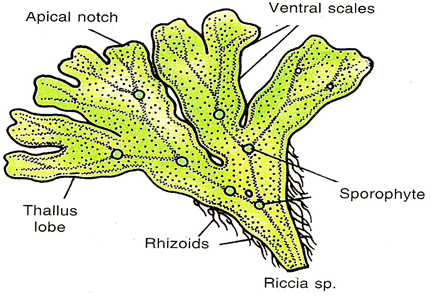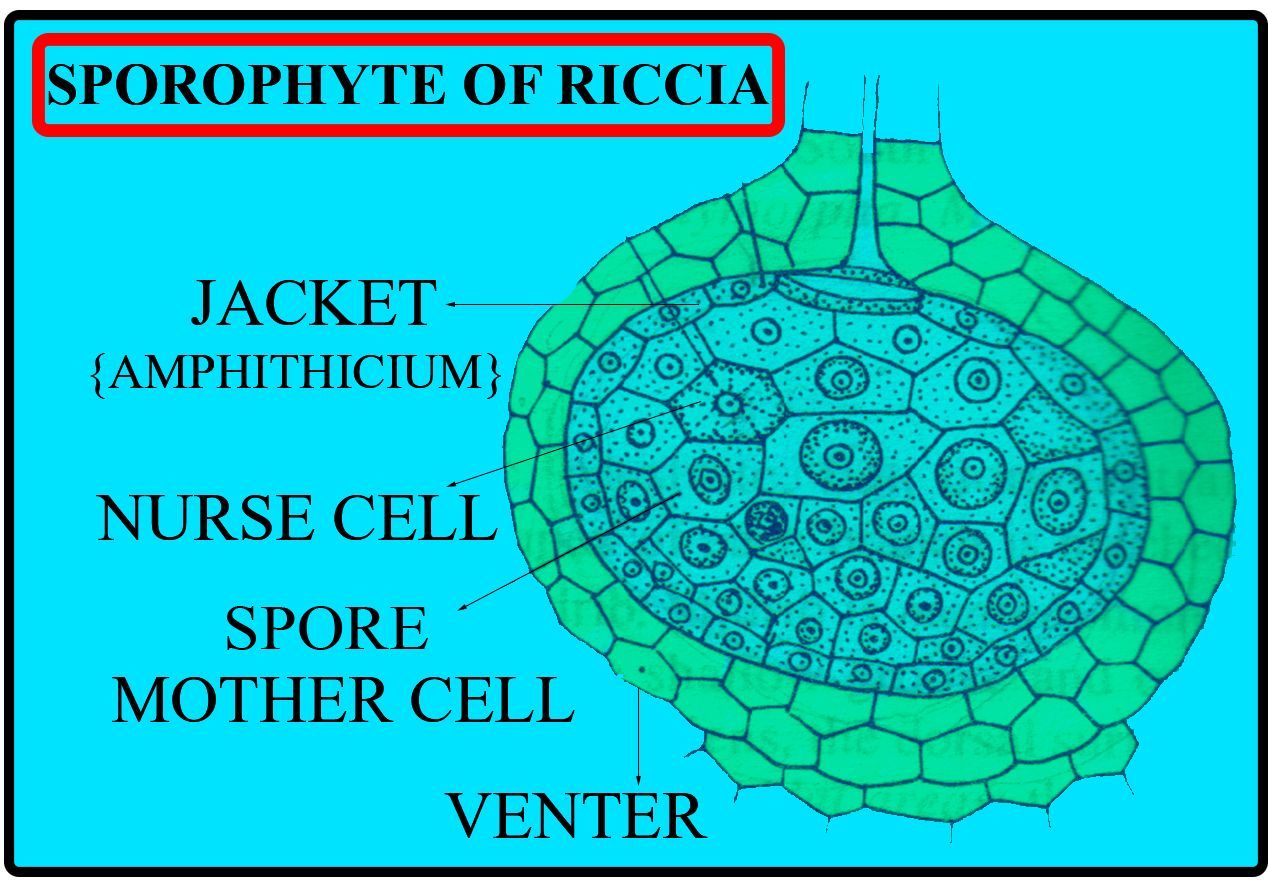Answer
323.1k+ views
Hint: Riccia is an aquatic, thallose liverwort whose capsule remains lodged within the thallus of gametophytes. Riccia's sporophyte is the simplest since it contains only capsules, missing both the foot and seta.
Complete answer:
A bryophyte's sporophyte (moss, liverwort, or hornwort) , usually consists of one foot, seta, and capsule. The mature capsule is filled with spores mixed with sterile cells or elaters and opens into valves by splitting. In Bryopsida, elders are absent. Elaters are diploid, spindle-shaped, elongated, hygroscopic structures with 2 spiral bands that help to dispersal spores.
Not all spore mother cells do develop spores in certain liverworts. Instead, several spore mother cells abort to become sterile nutritive or nurse cells that help nourish the spores that grow. This occurs for example in Riccia and Sphaerocarpos, the thallose liverwort genera.


So, the correct answer is, ‘Spores and nutritive cells’.
Additional Information:
The riccia sporophyte consists of a peripheral layer of cells that form the wall of the capsule and a central mass of the mother cell that contains spores.
The diploid zygote is the first generation of sporophyte cells. Shortly after the fertilization this cell secretes a membrane around it and enlarges in size and almost fills the center cavity. Subsequently, it undergoes division and hits the two-celled stage. The upper cell is called the epibasal cell, and the lower cell is called the parabasal cell. The two embryo cells (epibasal and hypobasal) further divide and give rise to a four-celled embryo stage followed by an eight-celled stage.
The embryo is subsequently separated into two parts. The outer layer is amphithecium, and endothecium is the inner mass of the cells. The amphithecium is defensive while the endothecium creates a mass of sporogenous cells.
Note: Spore Mother cells are created by sporogenous cells. Mother spore cells undergo meiotic division, forming tetrads. Thus a tetrad is composed of four spores. Only upon maturation the spores become isolated from one another. Naturally, the spores are haploid. The spores release themselves from the sporogonium on the death and decay of the thallus. The spores are small in number and probably spread by animals.
Complete answer:
A bryophyte's sporophyte (moss, liverwort, or hornwort) , usually consists of one foot, seta, and capsule. The mature capsule is filled with spores mixed with sterile cells or elaters and opens into valves by splitting. In Bryopsida, elders are absent. Elaters are diploid, spindle-shaped, elongated, hygroscopic structures with 2 spiral bands that help to dispersal spores.
Not all spore mother cells do develop spores in certain liverworts. Instead, several spore mother cells abort to become sterile nutritive or nurse cells that help nourish the spores that grow. This occurs for example in Riccia and Sphaerocarpos, the thallose liverwort genera.


So, the correct answer is, ‘Spores and nutritive cells’.
Additional Information:
The riccia sporophyte consists of a peripheral layer of cells that form the wall of the capsule and a central mass of the mother cell that contains spores.
The diploid zygote is the first generation of sporophyte cells. Shortly after the fertilization this cell secretes a membrane around it and enlarges in size and almost fills the center cavity. Subsequently, it undergoes division and hits the two-celled stage. The upper cell is called the epibasal cell, and the lower cell is called the parabasal cell. The two embryo cells (epibasal and hypobasal) further divide and give rise to a four-celled embryo stage followed by an eight-celled stage.
The embryo is subsequently separated into two parts. The outer layer is amphithecium, and endothecium is the inner mass of the cells. The amphithecium is defensive while the endothecium creates a mass of sporogenous cells.
Note: Spore Mother cells are created by sporogenous cells. Mother spore cells undergo meiotic division, forming tetrads. Thus a tetrad is composed of four spores. Only upon maturation the spores become isolated from one another. Naturally, the spores are haploid. The spores release themselves from the sporogonium on the death and decay of the thallus. The spores are small in number and probably spread by animals.
Recently Updated Pages
How do you arrange NH4 + BF3 H2O C2H2 in increasing class 11 chemistry CBSE

Is H mCT and q mCT the same thing If so which is more class 11 chemistry CBSE

What are the possible quantum number for the last outermost class 11 chemistry CBSE

Is C2 paramagnetic or diamagnetic class 11 chemistry CBSE

What happens when entropy reaches maximum class 11 chemistry JEE_Main

Calculate the volume occupied by 88 gram of CO2 at class 11 chemistry CBSE

Trending doubts
State the differences between manure and fertilize class 8 biology CBSE

Why are xylem and phloem called complex tissues aBoth class 11 biology CBSE

Difference between Prokaryotic cell and Eukaryotic class 11 biology CBSE

Difference Between Plant Cell and Animal Cell

What would happen if plasma membrane ruptures or breaks class 11 biology CBSE

Give 10 examples for herbs , shrubs , climbers , creepers

What precautions do you take while observing the nucleus class 11 biology CBSE

What would happen to the life of a cell if there was class 11 biology CBSE

Change the following sentences into negative and interrogative class 10 english CBSE



